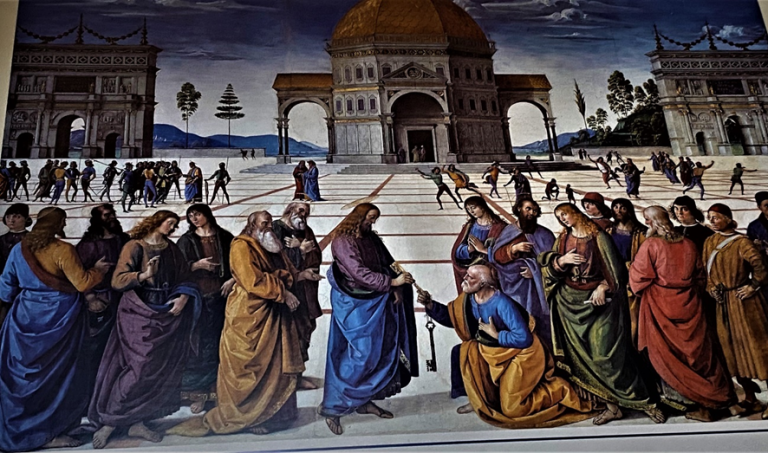

Jesus entrega as chaves do Reino para São Pedro – Pietro Perugino – Capela Sistina
As chaves do Paraíso
Olhe para esses personagens: há de todos os tamanhos! Os maiores estão dispostos em friso, um ao lado do outro na frente da cena. São eles que vemos primeiro; eles estão no “primeiro plano”.
Há também um “plano de fundo”: são os três edifícios representados na metade superior da pintura. Entre os dois, o pintor colocou personagens muito pequenos, para dar a impressão de distância. A pintura parece profunda, e ainda assim, a tela é plana! É um efeito de perspectiva.
No centro da composição, vemos Jesus dando as chaves a São Pedro, ajoelhado diante dele. Há duas chaves nesse molho: uma abre as portas do paraíso, a outra as da Igreja de Jesus na terra. Pedro as recebe ambas, pois Jesus o escolheu para construir sua Igreja e para guardar o reino dos céus. Ele não corre o risco de confundi-las: a chave do paraíso é toda dourada, é uma chave celestial.
Os outros apóstolos estão reunidos ao redor deles, suas auréolas são distinguíveis. Judas, o traidor, também está lá: uma bolsa pende de seu cinto; ele mergulha a mão nela lançando olhares desconfiados ao seu redor. Outros personagens cercam o grupo. Eles usam roupas diferentes, datadas da época do pintor, o Renascimento.
Olhe agora para os monumentos ao fundo: os dois arcos do triunfo são idênticos! Trata-se do Arco de Constantino, uma edificação famosa de Roma. Constantino é o primeiro imperador cristão; é por essa razão que esses arcos servem de cenário para a pintura.”
The keys to paradise
Look at these characters: there are all sizes! The largest are arranged in a frieze, side by side in front of the scene. They are the ones we see first; they are in the “foreground”.
There is also a “background”: these are the three buildings represented in the upper half of the painting. Between the two, the painter has placed very small characters, to give the impression of distance. The painting seems deep, and yet, the canvas is flat! It’s an effect of perspective.
At the center of the composition, we see Jesus giving keys to Saint Peter, who is kneeling before him. There are two keys in this bunch: one opens the doors of paradise, the other those of Jesus’ Church on earth. Peter receives both, for Jesus has chosen him to build His Church and to keep the kingdom of heaven. He is not likely to confuse them: the key to paradise is all golden, it’s a heavenly key.
The other apostles are gathered around them, their halos are distinguishable. Judas the traitor is there too: a purse hangs from his belt; he dips his hand into it while casting suspicious glances around him. Other characters surround the group. They are wearing different clothes, dating from the time of the painter, the Renaissance.
Now look at the monuments in the background: the two triumphal arches are identical! It is the Arch of Constantine, a famous building in Rome. Constantine is the first Christian emperor; it is for this reason that these arches serve as a backdrop for the painting.”
Les clefs du paradis
Regarde ces personnages : il y en a de toutes les tailles! Les plus grands sont disposés en frise, les uns à côté des autres devant de la scène. Ce sont eux que l’on voit d’abord ; ils sont au « premier plan ».
Il y a aussi un « arrière-plan » : ce sont les trois bâtiments représentés dans la moitié supérieure du tableau. Entre les deux, le peintre a placé de tout petits personnages, pour donner l’impression d’éloignement. Le tableau paraît profond, et pourtant, la toile est plate! C’est un effet de perspective.
Au centre de la composition, on voit Jésus qui donne des clefs à saint Pierre, agenouillé devant lui. Il y a deux clefs dans ce trousseau: l’une ouvre les portes du paradis, l’autre celles de l’Eglise de Jésus sur terre. Pierre les reçoit toutes les deux, car Jésus l’a choisi pour bâtir son Eglise, et pour garder le royaume des cieux. Il ne risque pas de les confondre: la clef du paradis est toute dorée, c’est une clef céleste.
Les autres apôtres sont réunis autour d’eux, on distingue leurs auréoles. Judas le traître est là aussi : une bourse pend à sa ceinture; il y plonge la main en jetant autour de lui des regards soupçonneux. D’autres personnages entourent le groupe. Ils portent des vêtements différents, datant de l’époque du peintre, la Renaissance.
Regarde à présent les monuments de l’arrière-plan : les deux arcs de triomphe sont identiques! Il s’agit de l’Arc de Constantin, un édifice célèbre de Rome. Constantin est le premier empereur chrétien ; c’est pour cette raison que ces arcs servent de décor au tableau.”
Fonte: Livro Les Saints – Marie Lhébrard – Edit. Bayard Jeunese
Produzido por / Organized by: MuMi – Museu Mítico
Consulte a Agenda do Museu a partir de 2025 e o visite quando receber sua confirmação de visita em seu email ou whatsapp.
Por se tratar de um museu particular, é necessário se cadastrar na Comunidade MuMi e customizar sua visita.
Criação e Tecnologia: Clayton Tenório @2025 MuMi – Museu Mítico